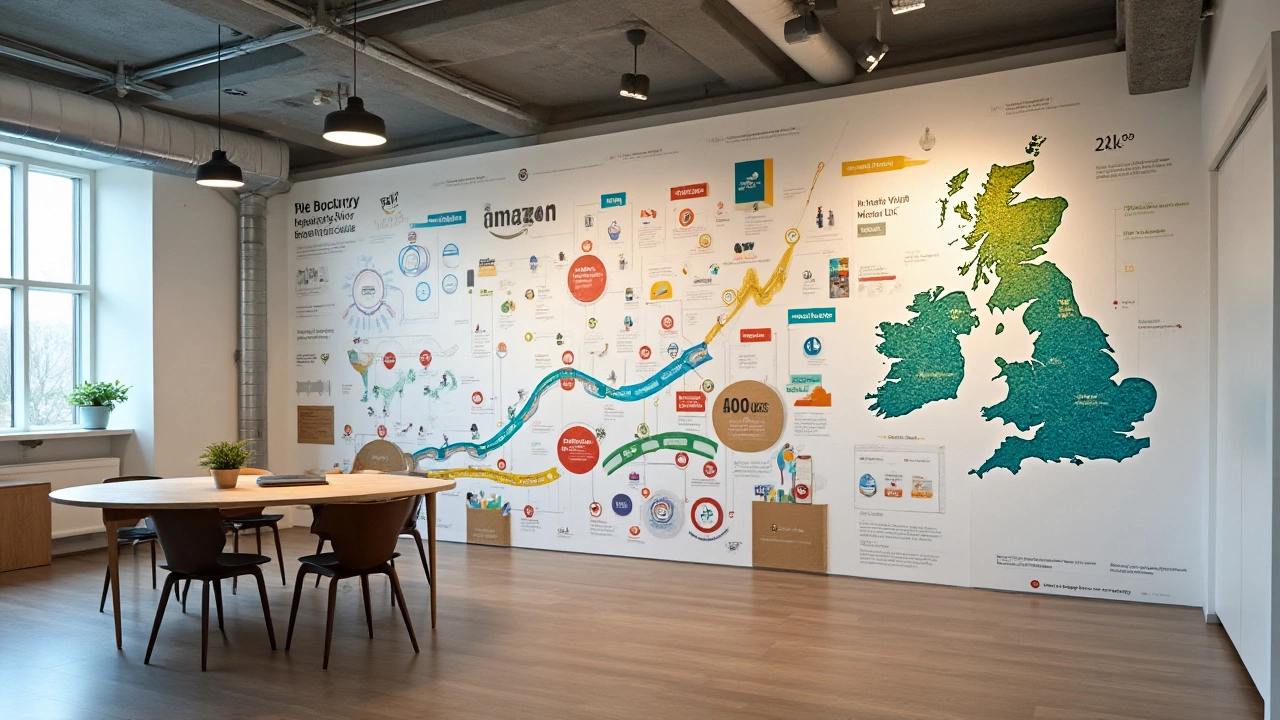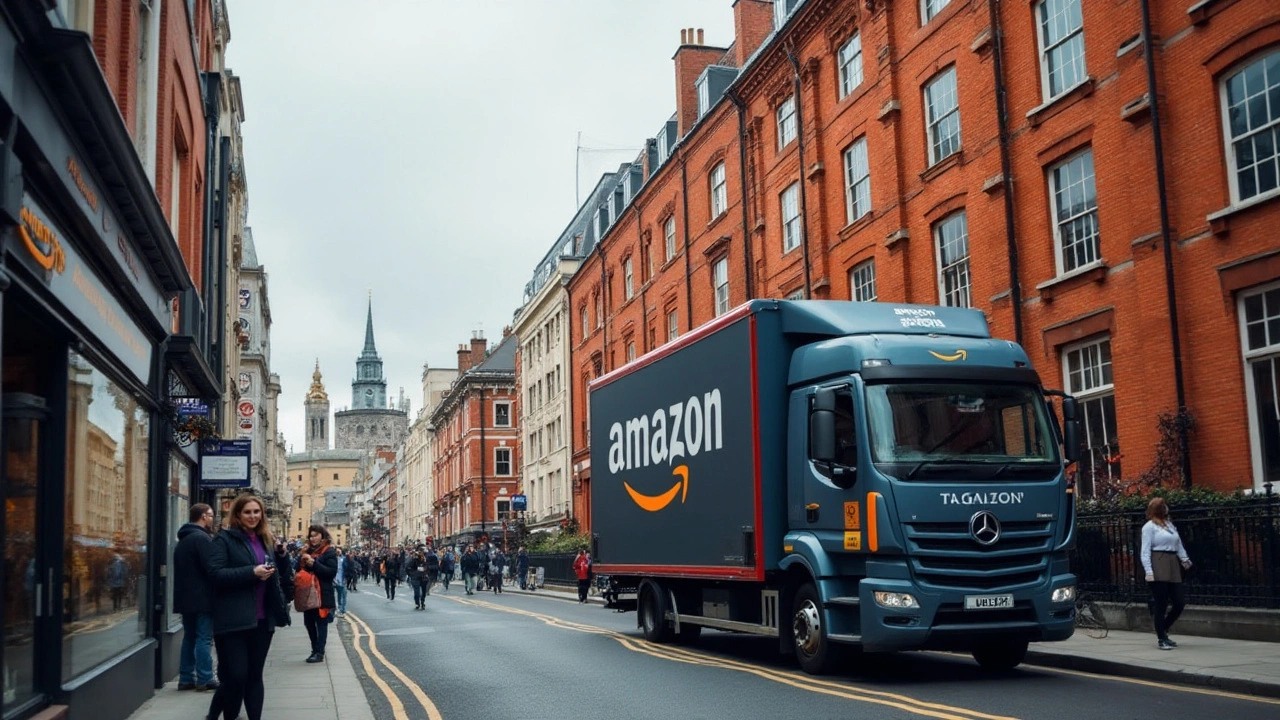We all have that image of Amazon as the place where you can buy just about anything, but it wasn't always this way. From its roots as a simple online bookstore, Amazon has expanded and transformed the world of e-commerce.
Join me on a journey through its origin story, business strategies, and countless innovations that have changed how we shop online today. We’ll also touch on some of the bumps it's encountered along the way and where things might head in the future.
- The Birth of Amazon
- Amazon's Business Model
- Innovations and Services
- Challenges and Criticisms
- Future of E-commerce
Amazon's Business Model
When it comes to Amazon's business model, it is crucial to understand that its strategic genius lies in diversification and integration. Initially conceptualized as an online bookstore by Jeff Bezos in 1994, Amazon soon evolved into a multifaceted digital marketplace. This transformation was driven by a combination of innovative ideas, an understanding of customer needs, and the implementation of advanced technologies. Amazon's model now encompasses not only e-commerce sales but also a significant cloud computing segment, subscription services, and advertising. The company's primary revenue streams include sales of goods both through its own stock and third-party sellers, Amazon Web Services (AWS), and Prime memberships.
Amazon's retail operations are supported by its expansive logistics network, which is a crowning jewel in its business model. This network empowers the company to offer services such as same-day delivery, giving it a competitive edge. The logistics arm includes warehouses—known as fulfillment centers—in key locations across the world, equipped with cutting-edge robotics and AI technology. This efficiency results in reduced shipping times and costs, pivotal for customer satisfaction and retention. Moreover, Amazon’s prowess is evident in its use of data analytics to predict consumer behavior and drive inventory decisions, ensuring they have the right products in the right places at the right times.
Another pivotal component of Amazon's model is its marketplace platform for third-party sellers. This strategy not only expands the company's product offerings but also generates significant revenue through commissions and fulfillment services. By enabling millions of independent sellers to reach an extensive customer base, Amazon has positioned itself as a mediator of global trade without bearing the full cost of inventory expansion. This has created a vast ecosystem benefiting both sellers hoping to capitalize on Amazon's reach and consumers looking for an endless array of products.
Amazon Web Services (AWS)
While most associate Amazon with shopping, AWS represents a vital part of the company's business model. Launched in 2006, AWS offers pay-as-you-go cloud services that have proven indispensable across various industries. This branch of Amazon's empire has not only provided an essential IT infrastructure for startups and enterprises but has also been a consistent growth driver for the company. In recent years, AWS has contributed significantly to Amazon's profitability, often being more profitable than the retail sector. Remarkably, the division’s customer list includes some of the most recognizable names from various sectors, from Netflix to NASA.
"AWS is a facilitator of empowerment and innovation, changing how businesses interact with technology," states a prominent tech analyst in a recent industry report.
The subscription services aspect of Amazon, exemplified by Prime, serves as both a revenue stream and a consumer loyalty tactic. The Prime membership, with its benefits of free shipping, exclusive deals, and streaming access, creates a sticky customer base. Furthermore, strategies such as continued expansion of original content and increasing the scope of Prime services indicate the company's ongoing commitment to strengthening this model aspect. Such diversification underscores Amazon’s ability to anticipate market shifts and leverage its comprehensive customer data in strategies that optimize growth and customer fulfillment.
| Revenue Source | Contribution to Total Revenue |
|---|---|
| Retail Operations | 60% |
| AWS | 13% |
| Third-Party Services | 19% |
| Subscription Services | 8% |
In essence, Amazon's business model is not merely about selling products online. Rather, it’s a sophisticated interplay of technology, logistics, and consumer behavior analytics that altogether craft one of the most intricate and successful e-commerce strategies in history. It's clear that understanding this business model is key to recognizing Amazon's stature as an e-commerce giant and its profound influence on global retail dynamics.

Innovations and Services
The transformation of Amazon from a simple online bookstore to a global e-commerce giant is a tale of innovation and customer-centric services. Its ability to continuously adapt and introduce new offerings has been pivotal. Amazon has developed a wide range of services that have shaped the e-commerce landscape, starting with Prime Membership which greatly altered shopping habits. For a minimal annual fee, customers are entitled to perks like two-day shipping, access to a gigantic library of movies, TV shows, and even exclusive deals. Amazon Prime's introduction not only boosted sales but also enhanced customer loyalty, creating an ecosystem where the convenience of expedited shipping is just a click away. This is not to mention the significance of Prime Day, which has become a global retail phenomenon.
One cannot discuss Amazon without mentioning Amazon Web Services (AWS). What many don't appreciate is just how instrumental AWS is to the internet infrastructure. Launched in 2006, AWS offers an immense scope of cloud computing services. This service arm of Amazon provides everything from data storage to machine learning capabilities, offering businesses an alternative to expensive in-house IT infrastructure. Where Amazon truly excels is in making the complicated accessible, thus allowing businesses of all sizes to benefit from cloud technologies. Did you know that by 2023, AWS controlled nearly a third of the global cloud infrastructure market, outperforming its closest competitors? Its reach is vast, serving countless well-known companies across diverse sectors.
Amazon's customer service is another area where it has set the bar high. While the e-commerce industry often struggles with returns and customer service teams, Amazon has prioritized hassle-free returns, making it a standard expectation for online shopping. This innovation minimizes buyer's remorse and enhances the customer's buying experience. They've leveraged technology like AI chatbots to streamline customer queries, reducing response times and freeing up human workers for more complex issues. This efficient approach culminates in happier customers and encourages repeat business. In a fascinating process, Amazon’s customer service receives continuous innovations, emphasizing feedback through extensive A/B testing and iterative improvements.
Amazon Go stores introduce yet another layer of innovation. What was once considered something straight out of a sci-fi novel, is now a reality with these cashier-less stores that offer 'Just Walk Out' technology. By using advanced sensors and AI, these stores allow shoppers to pick up products and leave without waiting in line. This seamless shopping experience is aimed primarily at improving convenience and reducing the time consumers spend in physical stores. Though still more of an experiment and only available in certain cities, they represent Amazon's commitment to redefining digital marketplaces.
Among other exciting innovations is Alexa, Amazon's entry into smart home technology. Alexa, powered by AI, is more than just a virtual assistant. It represents Amazon's venture into the emerging Internet of Things (IoT), providing users with control of their smart homes through voice commands. Whether it's ordering groceries, playing music, or controlling home appliances, Alexa epitomizes convenience. By establishing partnerships with various manufacturers, Alexa has a foothold in numerous devices, making it a staple in many homes. This positions Amazon not just as a retailer but as a tech company propelling forward the way humans interact with technology. As Marissa Mayer put it, "Alexa is Amazon's ongoing experiment to make our lives simpler and our routines more efficient."

Challenges and Criticisms
Amazon, the e-commerce giant, is not without its fair share of challenges and criticisms. Despite being a leader in the e-commerce sector, the company has faced significant scrutiny over various aspects of its operations. One prominent area of criticism is its labor practices. Reports have repeatedly highlighted issues within Amazon's warehouses, pointing to high-pressure environments and demanding performance quotas for workers. Employees have expressed concerns about the lack of breaks and emphasis on rapid order fulfillment, leading to widespread debates about workplace conditions.
Another area of concern for Amazon involves its market influence. As the company dominates the digital marketplace, many critics argue that it stifles competition, driving smaller businesses out of the market. The immense control Amazon wields has led to discussions on antitrust issues, with regulators examining how its market power impacts vendors and consumers. The issue of how Amazon's algorithms prioritize certain products over others has also been a talking point, affecting visibility and sales for independent sellers.
Furthermore, there are environmental concerns related to Amazon's vast supply chain and logistics network. As a business that thrives on rapid delivery, Amazon generates a significant carbon footprint through transportation. The packaging waste generated from millions of deliveries has led environmental activists to demand greater accountability and sustainable practices from Amazon. While the company has initiated programs to reduce its carbon emissions and committed to net-zero carbon impact, critics argue that these efforts need to be more aggressive and comprehensive.
Data privacy is another hot topic associated with Amazon, particularly in relation to its vast consumer data collection. The sheer volume of data collected by Amazon for enhancing targeted advertising and improving user experience raises questions about privacy and user consent. Concerns linger about how Amazon handles and protects this data amidst growing cyber threats. Addressing user trust remains foundational to resolving these issues.
"Amazon’s rapid expansion and scale have raised serious concerns about market consolidation and fair competition," states Dr. Harriet Klein, a renowned economist. Her insights underline a pressing need for international joint discussions on how to handle such expansive companies.
Lastly, Amazon has faced backlash over its approach to local taxation. Many critics point out that Amazon's complex financial structures allow it to minimize tax liabilities in key markets, sometimes avoiding taxes altogether in specific regions. This has triggered a global discussion on tax reform, pushing governments to find ways to equitably tax international tech giants and ensure fair contributions to national economies. As Amazon navigates through these challenges, it highlights the ongoing tension between business growth, ethical practices, and social responsibilities in today's interconnected world.

Future of E-commerce
The landscape of e-commerce is an ever-evolving tapestry, weaving together innovation with changing shopping habits. As we look towards the next decade, it's clear that the digital marketplace is bound to integrate deeper into our day-to-day lives. With technology advancing at a breakneck pace, we are poised to see a blending of reality with digital platforms. Augmented reality (AR) and virtual reality (VR) tools are no longer mere concepts of science fiction; they are gradually shaping how we preview and purchase products online. Imagine selecting furniture for your living room and being able to visualize exactly how it fits within your space using AR. Amazon is heavily investing in such technologies, aiming at making shopping not just a transactional experience, but an immersive one.
Societal shifts spur momentum toward sustainable shopping solutions. As environmental concerns mount, consumers demand eco-friendly products, and market giants like Amazon must adapt swiftly. Initiatives towards reduced packaging, carbon-neutral delivery options, and promoting sustainable products are already gaining traction. This transformation is not just a moral imperative, but it’s becoming a business necessity. An interesting stat from the 'Global E-commerce Trends 2024' report highlights that 65% of online shoppers prefer brands committed to sustainability. As this trend solidifies, those who lead the charge in sustainable practices will likely capture significant market share.
An interesting prediction from the World Economic Forum suggests that by 2030, 60% of the global population will engage in e-commerce. That's billions of potential customers, each bringing unique needs and expectations. The vast challenge lies in personalizing the shopping experience on this massive scale without drowning in data. Artificial intelligence and machine learning will become crucial tools in understanding buyer behavior and predicting preferences. These technologies use algorithms that can analyze millions of data points, refining individual customer experiences swiftly and accurately. The key for companies like Amazon will not only be in harnessing this power but doing so with transparency and respect for customer privacy.
The future of online shopping is also set to redefine concepts of delivery. Rapid and free shipping is no longer a novelty, but rather, an expectation. Marketplace giants are racing to develop infrastructure that facilitates instant delivery – think drones dropping off your orders within minutes. While regulatory and logistical hurdles remain, advancements could soon make this dream a reality, thereby changing the entire supply chain landscape. The incorporation of autonomous vehicles and drones in the delivery process holds the potential to disrupt traditional transport methods, making faster, more efficient deliveries the norm.
"The only constant in e-commerce is change," claims the e-commerce guru, Taavi Kotka. Businesses must embrace technological advancements and consumer demands, avoiding complacency at all costs.As the number of digital marketplaces expands, competition will intensify, causing businesses to innovate continuously. Amazon’s focus might increasingly shift to niche sectors as well, responding to customized needs with specialized platforms catering to specific interests or demographics. The future beckons exciting, transformative shifts, and staying ahead in the e-commerce race will require agility, innovation, and a keen eye on evolving trends.
